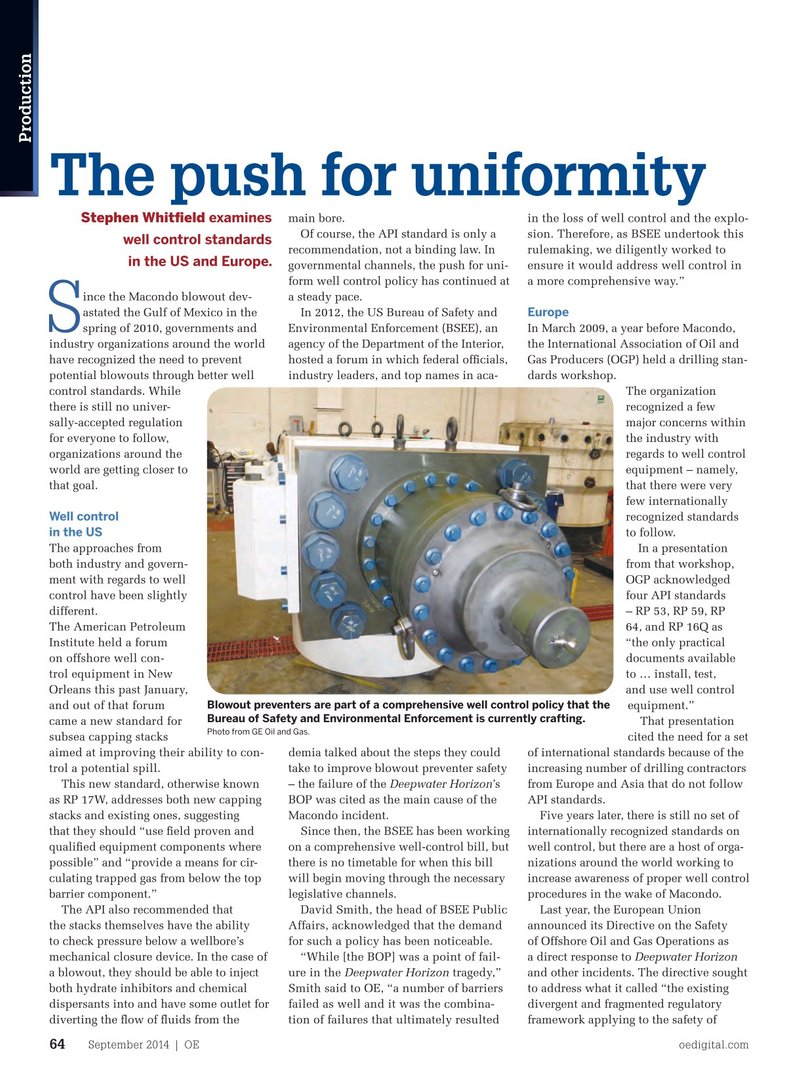
Page 62: of Offshore Engineer Magazine (Sep/Oct 2014)
Read this page in Pdf, Flash or Html5 edition of Sep/Oct 2014 Offshore Engineer Magazine
offshore oil and gas operations” between its member states.
The EU directive touched on a wide range of issues, including response and liability in the case of a blowout and, as
Eyebrow Production the name would suggest, preventative measures. Most importantly, it called for independent, expert regulators to assess the capacity of wells in each of its
The push for uniformity countries with well operations.Under the in the loss of well control and the explo- main bore. directive, EU countries that are not land-
Stephen Whit? eld examines sion. Therefore, as BSEE undertook this Of course, the API standard is only a locked have until June 2015 to imple- well control standards rulemaking, we diligently worked to recommendation, not a binding law. In ment the directive into law. in the US and Europe.
ensure it would address well control in governmental channels, the push for uni- By 2016, the European Commission will a more comprehensive way.” form well control policy has continued at report on the progress of the implementa- a steady pace. ince the Macondo blowout dev- tion of this directive to both the European
Europe
In 2012, the US Bureau of Safety and astated the Gulf of Mexico in the Parliament and the European Council.
S spring of 2010, governments and Environmental Enforcement (BSEE), an In March 2009, a year before Macondo,
International organizations industry organizations around the world agency of the Department of the Interior, the International Association of Oil and
Gas Producers (OGP) held a drilling stan- hosted a forum in which federal of? cials, have recognized the need to prevent Elsewhere, other organizations are lead- dards workshop. industry leaders, and top names in aca- potential blowouts through better well ing the way in researching the possibil-
The organization control standards. While ity of a uniform standard and educating recognized a few there is still no univer- others about well control. major concerns within sally-accepted regulation The International Regulators’ Forum the industry with for everyone to follow, (IRF) has already of? cially supported regards to well control organizations around the the International Organization for equipment – namely, world are getting closer to Standardization (ISO) standards system. that there were very that goal. However, ISO standards are far from a be- few internationally all, end-all, and the IRF’s Offshore Safety
Well control recognized standards Conference in Perth last fall featured in the US to follow.
The approaches from In a presentation both industry and govern- from that workshop, ment with regards to well OGP acknowledged control have been slightly four API standards different. – RP 53, RP 59, RP
The American Petroleum 64, and RP 16Q as
Institute held a forum “the only practical on offshore well con- documents available trol equipment in New to … install, test,
Orleans this past January, and use well control
Blowout preventers are part of a comprehensive well control policy that the and out of that forum equipment.”
Bureau of Safety and Environmental Enforcement is currently crafting. came a new standard for That presentation
Photo from GE Oil and Gas.
subsea capping stacks cited the need for a set aimed at improving their ability to con- demia talked about the steps they could of international standards because of the trol a potential spill. take to improve blowout preventer safety increasing number of drilling contractors
This new standard, otherwise known – the failure of the Deepwater Horizon’s from Europe and Asia that do not follow as RP 17W, addresses both new capping BOP was cited as the main cause of the API standards. stacks and existing ones, suggesting Macondo incident. Five years later, there is still no set of that they should “use ? eld proven and Since then, the BSEE has been working internationally recognized standards on quali? ed equipment components where on a comprehensive well-control bill, but well control, but there are a host of orga- possible” and “provide a means for cir- there is no timetable for when this bill nizations around the world working to culating trapped gas from below the top will begin moving through the necessary increase awareness of proper well control barrier component.” legislative channels. procedures in the wake of Macondo.
The API also recommended that David Smith, the head of BSEE Public Last year, the European Union the stacks themselves have the ability Affairs, acknowledged that the demand announced its Directive on the Safety to check pressure below a wellbore’s for such a policy has been noticeable. of Offshore Oil and Gas Operations as mechanical closure device. In the case of “While [the BOP] was a point of fail- a direct response to Deepwater Horizon a blowout, they should be able to inject ure in the Deepwater Horizon tragedy,” and other incidents. The directive sought both hydrate inhibitors and chemical Smith said to OE, “a number of barriers to address what it called “the existing dispersants into and have some outlet for failed as well and it was the combina- divergent and fragmented regulatory diverting the ? ow of ? uids from the tion of failures that ultimately resulted framework applying to the safety of
September 2014 | OE oedigital.com 64 064_OE0914_ProdOps1_overview.indd 64 8/21/14 5:20 PM

 61
61

 63
63